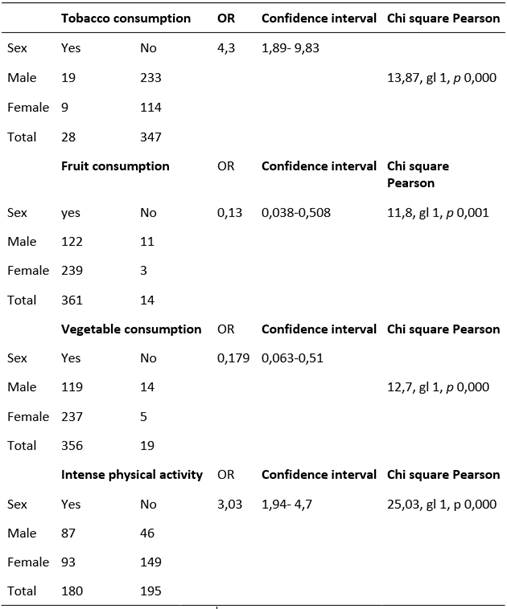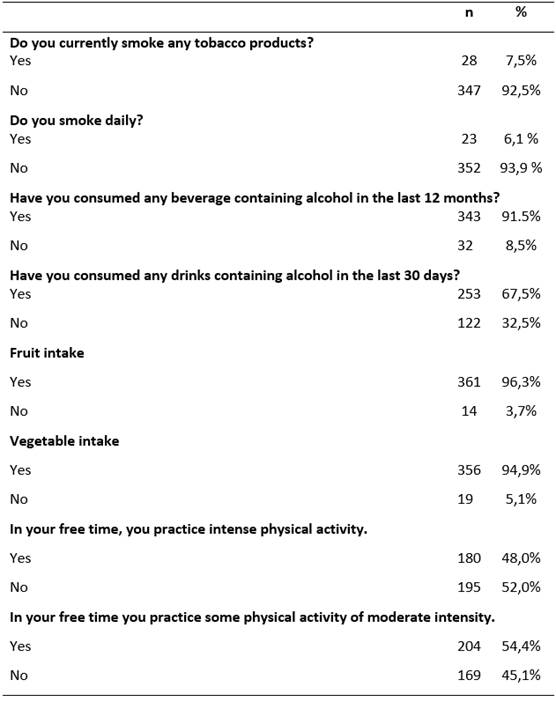Introduction
Chronic non-communicable diseases (NCDs) represent one of the most significant challenges of the 21st century due to the social, economic, and human repercussions that impact negatively on poor and vulnerable populations and affect the sustainable development of a country from the point of view of its productivity. 1.
In 2014, the World Health Organization (WHO) reported that 71% of Colombian deaths were caused by chronic non-communicable diseases, from which 28% were cardiovascular diseases, 17% cancer, 7% chronic respiratory diseases, 3% diabetes, and 16% other NCDs 2.
The risk factors for developing NCDs are mostly modifiable. These are associated with environmental and psychosocial factors, lifestyles, behaviors, and habits acquired in adolescence and maintained during college life 3. Behavioral risk factors such as smoking, alcohol consumption, physical inactivity and unhealthy diets 4 are in a first place 5; by being this last one that presented an increase in the intake of foods rich in saturated fats and trans fatty acids along with the low consumption of fruits and legumes 6)(7.
According to Patiño et al. 8, low levels of physical activity, obesity, smoking, and metabolic syndrome are the most prevalent cardiovascular risk factors in adolescents. Alcohol consumption is associated with the risk of developing important Noncommunicable diseases (NCDs) such as liver cirrhosis, some types of cancer and cardiovascular diseases. 9 According to statistics from the World Health Organization in Colombia, 71% of deaths are caused by non-communicable diseases, 28% by cardiovascular diseases, 17% by cancer, 7% by chronic respiratory diseases and 3% by diabetes 7.
This paper aims at contributing to the discussion on this subject by identifying risk behaviors or threats that can be reduced or prevented from the university context.
Methods
Study design: This research corresponds to a cross-sectional descriptive study, which was carried out in university students living in Neiva, Huila, Colombia for the period of 2014 to 2015 through a non-probability sampling method.
Population:
A total of 15,889 students that were enrolled in the first semester of the academic year from 5 universities were identified; This was one of the requirements that were necessary for being part of the study and it was determined considering that the transition from secondary school to higher education implies a significant change in life, including unfavorable changes in behaviors related to eating habits, health, and weight gain for many students. 10)(7.
The study selected 375 students who met the following inclusion criteria: to be 18 years old or older, to be enrolled in any face-to-face program at public or private universities in the city of Neiva, to be in first semester of college, and agree to participate in the study by signing informed consent and completing the stepwise questionnaire (Step 1 Behavior Measurements). Students who were attending higher semesters and those who reported being diagnosed with a chronic non-communicable disease were excluded.
Instruments: The stepwise method was used as a source of information, specifically the STEP 1, which estimates the relationship of behavioral measurements for the monitoring of risk factors for non-communicable diseases, this is a validated and free-to-use tool of the WHO 11. This tool covers information in the main section on tobacco use, alcohol consumption, diet, and physical activity in leisure time.
At the procedural level, only the basic questions of the instrument were considered: tobacco use, alcohol consumption, and physical activity in leisure time.
The instrument was applied by students of the Physiotherapy program belonging to the research group called Visionaries of Science of the María Cano University Foundation in Neiva, who were trained for its application after performing a pilot test.
Statistical analyses: The statistical analysis was carried out with the 21.0 version of the SPSS statistical package, which included descriptive statistics and bivariate analysis by calculating Chi-square statistics and OR (95% CI) to determine possible relationships between the study variables.
Ethical responsibilities: This research was approved by the María Cano University Foundation's research committee, act #001, with the assignment code #01300416-2014-311. It was carried out under the general principles of the Helsinki Declaration 8 and resolution 008430 of the 4 of October 1993 as a minimum risk research 9.
Results
From the total number of subjects in the study sample (n=375), 242 (64.5 %) were female and 133 (35.5%) were male; the average age was 20 years old. In terms of socioeconomic level, most of the participants were in the low and medium-low level which belong to a subsidized health plan; they were on academic programs of health and engineering.
There was a prevalence of tobacco use in 28 people (7.5%), alcohol consumption in 343 people (91.5%) in the last year, and in 267 people (71.2%) in the previous 30 days. In addition, 361 (96.3%) university students intake fruit, 356 (94.9%) intake vegetables, and 180 (48%) do physical activity in their free time (Table 1).
Source: Own source
In the bivariate analysis, a strong relationship was identified between the male sex, tobacco use (OR 4.3; 95% CI 1.89-9.83), and physical activity practice (OR 3.03; 95% CI 1.94-4.7) and an inverse relationship with the variables fruit intake (OR 0.13; 95% CI 0.038-0.508), and vegetable intake (OR 0.179; 95% CI 0.063-0.51) (Table 2).
Table 2 Behaviors related to chronic non transmissible diseases in university students, according to sex.

Source: Own source
Discussion
From this study, the presence of behaviors associated with the development of NCDs was described in a group of university students. In 2008, the World Health Organization (WHO) established that physical inactivity, smoking, harmful use of alcohol, and unhealthy diets were the behavioral risk factors associated with NCDs 14, these conditions are not unknown to the college population and, on the contrary, these make them vulnerable 15. In 2010, such unhealthy behaviors were responsible for approximately 21.5 million worldwide deaths, mainly because the inadequate eating habits 16.
For the present study, the presence of high alcohol consumption and low adherence to physical activity were the main risk factors associated with the development of NCDs. Contrary to what the WHO established in 2008, and to what other inquiries have recorded regarding the wide range of smoking prevalence in college students 17, low tobacco consumption was found in this study. In relation to sex, men are the biggest consumers, results that are similar to what has been reported in previous research 18)(19)(20. The low tobacco use found in this study could be related to the promotion of tobacco-free environments and educational campaigns for the prevention and reduction of smoking in the university context.
Regarding alcohol consumption, a high prevalence was found. This is consistent with the results obtained in the National Study of psychoactive substance use in Colombia, the highest current alcohol use rate is 49.2% and it occurs among young people from 18 to 24 years, and the consumption among people between 25 to 34 years represents 45.4% 21. Salcedo et al. (2011), found that 73% of college students consumed alcohol 22. In addition, other research suggests that a significant proportion of breast and colon cancer cases may be attributable to excessive alcohol consumption 23. Harmful alcohol consumption in the university population represents a delicate public health problem owing to its association not only with the risk of suffering from NCDs, but also to develop liver diseases, and mental and behavioral disorders 24. These increase the risk of college students to present harmful behaviors that would negatively impact their future. The resulting situations to which alcohol consumers are exposed includes suicides, injuries, engaging in violent acts (traffic accidents, scuffles) and practicing unsafe sex 22. In terms of the intake of fruits and vegetables a high percentage was found, these results are similar to the ones reported by Restrepo et al 25. In contrast, studies on eating behaviors mostly highlight unbalanced macronutrient intakes and significant nutritional deficits of micronutrients in college students due to the short time spent by them on preparing healthy foods and the ease access they have to "junk food" 26)(27.
The results obtained in this study are encouraging, takin into account that the intake of fruits and vegetables is considered as a protective factor for the development of non-communicable diseases and for the proper maintenance of the Body Mass Index (BMI) in university students 28.
Finally, it was found that most of the university students surveyed showed little physical activity in their free time, which is consistent with other studies on physical activity in university populations worldwide. In the United States, the levels of sedentary lifestyle in a study conducted with college students registered 86.6% 29, while a meta-analysis of physical activity behaviors in college students established percentages between 40% and 50% 30. Concerning sex, university women reported lower levels of physical activity when compared to men. This finding has been widely described by the scientific literature in the last decade 31)(17)(32)(15.
Deforche et al., (2015), stated that low levels of physical activity in college students are the result of an age-related process since they become less active as time passes in the transition between adolescence and adulthood. Thus, the level of physical activity of the last year of university would predict the level of physical activity after graduation and prevails during adulthood 10.
This research presents limitations that are typical of cross-sectional studies. In addition, sociodemographic variables such as academic and socioeconomic level were not included; these would have been important in the analysis of the results.
Conclusions
This study represents a contribution to the characterization of the lifestyles of university students. A high prevalence of alcohol consumption was found, and in contrast, low levels of tobacco use and physical activity were found. These findings are an invitation to continue strengthening strategies to enhance a health-promoting environment for the educational community in the University, which mitigates the development of future complications and reverses the current upward trend in the development of chronic diseases.















